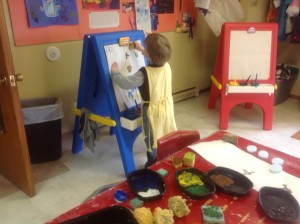 Do you wish you had a magic wand to get your preschooler to do what you ask? Try using this phrase: “I need you to…. put away the toys now.” You will be amazed at the response. Do you want to know why this works? Keep reading.
Do you wish you had a magic wand to get your preschooler to do what you ask? Try using this phrase: “I need you to…. put away the toys now.” You will be amazed at the response. Do you want to know why this works? Keep reading.
Basically, the child is learning language and so far they respond in “literal” terms. When you ask if they “want” to do something, they will answer honestly. If they don’t “want” to, they will say no. Then you are stuck with changing your “question” into a command, which rarely works. At this point they don’t understand what they have done wrong, or why you are upset with them. They answered trusting their true answer was what you wanted. So, what do you do? The challenge is re-thinking the way you think and thinking the way they think. It’s not easy because of our old habits of communication.
Saying “I need” you to …. put away your toys, wash your hands, put your coat away… etc. give’s them a sense of purpose. You have a need for which they can help. Sometimes if they are reluctant, you can express it with more genuine attention and say something like, “I need your help. I need you to … put away your toy.” Most children at this age are all about being helpful, so now you have their attention.
If they are engaged in play and they don’t want to stop playing, you can address that issue and say, “I see that you are busy playing and don’t want to help. But, right now I need you to … pick up the toys. You can play with them again later, after …. (whatever reason you have.. such as, it’s time to eat, it’s time to go to bed, it’s time to go to the store.) If you also say, “Play time is over. It’s now sleep time,” or whatever, that also helps them to accept the change, which we call a transition.
Be careful with saying things like, “I have to… go to the store, go run errands… etc.” In their mind that means an emergency, and if it’s not, they are confused. You might have even heard them say, “No you don’t.” That is their logic. It’s better to say, “It’s time to… to to the store… etc.”
Transitions are difficult for this age to accept. It’s kind of like being woke up in the middle of the night in the middle of a great dream. You want to capture what you were doing, or thinking and remember it. The same is true of their thoughts and play. They want to capture it and continue. It may take them a few minutes to switch their thinking, or lock the thoughts in their mind so they can return to it later. It also helps to tell them when they can return to the activity they are stopping. “I can see you want to continue playing. You really like playing with those cars, don’t you. You can play that again… after dinner…. after nap… when we get back from the store, or tomorrow.”
Patience is the key at this point. Allowing them the time to disengage and move may take three to five minutes. Talking with them about the play a bit more can also help. “Tell me what the cars were doing; where were they going? What are they going to do next? Good, we can remember that later when “it’s time” to play cars again.”
In the beginning, it might take longer. But, if you keep your word and allow them to return to the activity when you said, it will become easier the next time. You should prompt them when it’s time to return, “Dinner’s is over, you can play with the cars now.” But, keep in mind, you don’t want to promise they can return to play if you can’t deliver on the promise. It’s better to say you don’t know when they can play again than give them a time and not follow through.
Hope this helps and please leave a comment here and let me know how it works. Also share it on FB and Please “like” our FB page.
